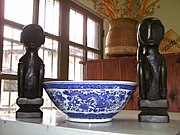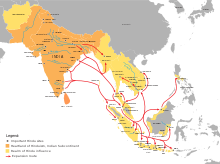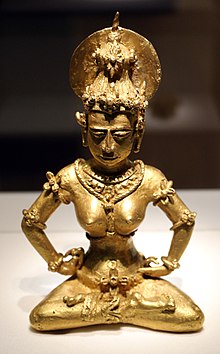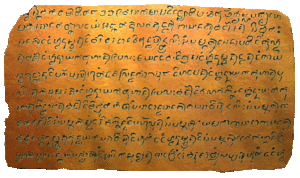
The Laguna Copperplate Inscription is an official acquittance certificate inscribed onto a copper plate in the Shaka year 822. It is the earliest known calendar-dated document found within the Philippine Islands.

The history of Asian art includes a vast range of arts from various cultures, regions, and religions across the continent of Asia. The major regions of Asia include Central, East, South, Southeast, and West Asia.

Recent archaeological and other evidence suggests Hinduism has had some cultural, economic, political and religious influence in the Philippines. Among these is the 9th century Laguna Copperplate Inscription found in 1989, deciphered in 1992 to be Kawi script with Sanskrit words; the golden Agusan statue discovered in another part of Philippines in 1917 has also been linked to Hinduism.

A kinnara is a creature from Hindu and Buddhist mythology. They are described as part human and part bird, and have a strong association with music and love. Believed to come from the Himalayas, they often watch over the well-being of humans in times of trouble or danger. An ancient Indian string instrument is known as the Kinnari vina. Their character is also clarified in the Adi Parva of the Mahabharata, where they say:
We are everlasting lover and beloved. We never separate. We are eternally husband and wife; never do we become mother and father. No offspring is seen in our lap. We are lover and beloved ever-embracing. In between us we do not permit any third creature demanding affection. Our life is a life of perpetual pleasures.
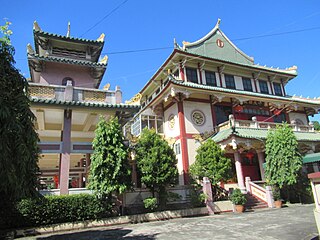
Buddhism is a minor religion in the Philippines. It is practiced by 2% of the population in 2020, primarily by Filipinos of Chinese descent.

Buddhist art is visual art produced in the context of Buddhism. It includes depictions of Gautama Buddha and other Buddhas and bodhisattvas, notable Buddhist figures both historical and mythical, narrative scenes from their lives, mandalas, and physical objects associated with Buddhist practice, such as vajras, bells, stupas and Buddhist temple architecture. Buddhist art originated in the north of the Indian subcontinent, in modern India, Pakistan and Afghanistan, with the earliest survivals dating from a few centuries after the historical life of Siddhartha Gautama from the 6th to 5th century BCE.

The Agusan image is a 2 kg (4.4 lb), 21-karat gold statuette, found in 1917 on the banks of the Wawa River near Esperanza, Agusan del Sur, Mindanao in the Philippines, dating to the 9th–10th centuries. The figure, approximately 178 mm (7.0 in) in height, is of a female Hindu or Buddhist deity, seated cross-legged and wearing a richly-adorned headdress and other ornaments on various parts of the body. It is now on display in the Field Museum of Natural History in Chicago.

In early Philippine history, the Tagalog settlement at Tondo sometimes referred to as the Kingdom of Tondo, was a major trade hub located on the northern part of the Pasig River delta, on Luzon island. Together with Maynila, the polity (bayan) that was also situated on the southern part of the Pasig River delta, had established a shared monopoly on the trade of Chinese goods throughout the rest of the Philippine archipelago, making it an established force in trade throughout Southeast Asia and East Asia.

In Philippine history, the Tagalog bayan of Maynila was one of the most cosmopolitan of the early historic settlements on the Philippine archipelago. Fortified with a wooden palisade which was appropriate for the predominant battle tactics of its time, it lay on the southern part of the Pasig River delta, where the district of Intramuros in Manila currently stands, and across the river from the separately-led Tondo polity.

Butuan, also called the Rajahnate of Butuan and the Kingdom of Butuan, was a precolonial Bisaya polity (lungsod) centered around northeastern Mindanao island in present-day Butuan, Philippines. It was known for its gold mining, gold jewelry and other wares, and its extensive trade network across maritime Southeast Asia and elsewhere. Over its long history the lungsod had direct trading relationships with the ancient civilizations of China, Champa, Đại Việt, Pon-i (Brunei), Srivijaya, Majapahit, Kambuja, and even Persia as well as areas now comprised in Thailand.
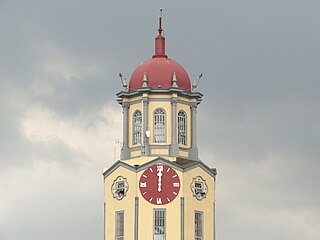
The earliest recorded history of Manila, the capital of the Philippines, dates back to the year 900 AD as recorded in the Laguna Copperplate Inscription. By the thirteenth century, the city consisted of a fortified settlement and trading quarter near the mouth of the Pasig River, the river that bisects the city into north and south.

Ma-i, or Maidh, was an ancient sovereign state located in what is now the Philippines.

The history of Luzon covers events that happened in the largest island of the Philippine Archipelago, Luzon. Luzon wrested the record of having the oldest man ever discovered in the Philippines with discovery of the Callao Man in 2007, which predated the Tabon Man by around 20,000 years. The written history of Luzon began in around 900 AD with the discovery of the Laguna Copperplate Inscription in 1989. After that, Luzon began to appear in the annals of the Chinese and Japanese. One example would be the Ming Shilu, wherein Luzon appeared in 22 records. Luzon was split among Hindu-Buddhist kingdoms, Muslim principalities, and ethnoreligious tribes, who had trading connections with Borneo, Malaya, Java, Indochina, India, Okinawa, Japan and China before the Spanish established their rule. As a result of the Spanish–American War, Luzon became American territory. In the Second World War, Luzon saw one of the fiercest battles during the Japanese occupation. Luzon, apart from being the largest island, had been the economic and political center of the Philippines ever since the country entered the Western Calendar, being home to the country's capital city, Manila, and the country's largest metropolis, Metro Manila.

Southeast Asia was in the Indian sphere of cultural influence from 290 BCE to the 15th century CE, when Hindu-Buddhist influences were incorporated into local political systems. Kingdoms in the southeast coast of the Indian subcontinent had established trade, cultural and political relations with Southeast Asian kingdoms in Burma, Bhutan, Thailand, the Sunda Islands, Malay Peninsula, Philippines, Cambodia, Laos, and Champa. This led to the Indianisation and Sanskritisation of Southeast Asia within the Indosphere, Southeast Asian polities were the Indianised Hindu-Buddhist Mandala.
Old Tagalog, also known as Old Filipino, is the earliest form of the Tagalog language during the Classical period. It is the primary language of pre-colonial Tondo, Namayan and Maynila. The language originated from the Proto-Philippine language and evolved to Classical Tagalog, which was the basis for Modern Tagalog. Old Tagalog uses the Tagalog script or Baybayin, one of the scripts indigenous to the Philippines.
Malay is spoken by a minority of Filipinos, particularly in the Palawan, Sulu Archipelago and parts of Mindanao, mostly in the form of trade and creole languages, such as Sabah Malay.

Malays played a significant role in pre-Hispanic Philippine history. Malay involvement in Philippine history goes back to the Classical Era with the establishment of Rajahnates as well as the Islamic era, in which various sultanates and Islamic states were formed in Mindanao, the Sulu Archipelago, and around Manila.
The Indian influences in early Philippine polities, particularly the influence of the Srivijaya and Majapahit thalassocracies on cultural development, is a significant area of research for scholars of Philippine, Indonesian, and Southeast Asian history, and is believed to be the source of Hindu and Buddhist elements in early Philippine culture, religion, and language. Because the Indonesian thalassocracies of Srivijaya and Majapahit acquired many of these Hindu and Buddhist elements through Indianization, the introduction of such elements to early Philippine cultures has sometimes been referred to as indianization. In more recent scholarship, it is termed localization, as in, e.g., localization of Hindu and Buddhist beliefs. Some scholars also place the Philippine archipelago within the outermost reaches of the Indosphere, along with Northern Vietnam, where the Hindu and Buddhist elements were not directly introduced by Indian travellers.

The archaeology of the Philippines is the study of past societies in the territory of the modern Republic of the Philippines, an island country in Southeast Asia, through material culture.

